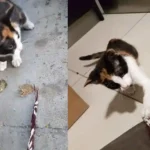You spot a pot of hyacinths at the local garden center—bright purple, pink, or white blooms, smelling like spring in a single breath. Naturally, you think, That would look beautiful on the windowsill.
But wait. You have a cat. A curious, jump-on-everything, chew-on-anything kind of cat. Suddenly, that innocent plant turns into a question mark. Are hyacinths toxic to cats?
The short answer is yes. And if you’ve got a cat who likes to nibble, you should know some essential things before bringing one into your home.
What Are Hyacinths, Exactly?
Hyacinths are flowering plants that belong to the same family as tulips—the lily family, to be exact. That’s your first red flag.
They grow from bulbs and are popular in springtime bouquets and home gardens because of their bold colors and intense fragrance. But while they’re stunning, they come with a hidden danger for our feline friends.
Yes, Hyacinths Are Toxic to Cats
Every part of the hyacinth plant is toxic to cats. But the bulbs are the most dangerous. They contain high concentrations of oxalates and alkaloids, which can irritate a cat’s mouth and digestive system and even affect their heart and nervous system in severe cases.
Even a small amount—especially from the bulb—can cause severe symptoms.
What Happens If a Cat Eats a Hyacinth?
The effects depend on how much your cat eats and which part of the plant they chew on. Here’s what to watch for:
Common Symptoms:
- Drooling
- Vomiting
- Diarrhea
- Loss of appetite
- Trembling or shaking
- Rapid breathing
- Lethargy
- Increased heart rate
Most symptoms show up quickly, often within minutes to a few hours.
And if your cat dug into the bulb? That’s the worst-case scenario. Bulbs are concentrated with toxins, and even a small bite can be dangerous.
Real-Life Example: “I Had No Idea It Was Harmful”
A friend once told me about her indoor cat, Luna. She had just bought a lovely pot of hyacinths for Easter and placed them on her dining table. A couple of hours later, Luna started drooling and seemed disoriented.
It turns out that Luna had chewed part of a leaf and licked the soil. Thankfully, after a stressful vet visit, she recovered—but it was a scary lesson. My friend now Googles every plant before bringing it home.
What to Do If Your Cat Eats a Hyacinth
If you think your cat has chewed or eaten any part of a hyacinth, here’s what to do:
1. Stay Calm but Act Fast
Panic won’t help, but time matters. Cats are small, so even a little toxin can hit hard.
2. Remove Access to the Plant
Move the plant out of reach immediately. If your cat still has bits in their mouth, gently remove them.
3. Call Your Vet or Emergency Clinic
Tell them what your cat ate and how much, if you can guess. They might ask you to come in right away.
4. Watch for Symptoms
Keep an eye out for vomiting, weakness, or signs of pain. Even if your cat seems okay, don’t assume it’s over. Some effects take time to show.
Are All Spring Bulbs Dangerous?
Not all, but many of them are. Here’s a quick look at standard spring bulbs that are also toxic to cats:
- Tulips
- Daffodils
- Crocus
- Amaryllis
- Lilies (especially deadly)
So, if you’re planning a spring garden or decorating your home with blooms, check each one carefully before bringing them into a cat-friendly space.
Safer Alternatives to Hyacinths
Love the look of flowers but want to keep things safe? Here are some cat-friendly plants and flowers that can brighten your home without the risk:
- African Violet
- Spider Plant
- Areca Palm
- Calathea
- Orchids (most varieties)
- Snapdragons
- Marigolds
And, of course, you can always grow cat grass or catnip just for them. It keeps their curiosity satisfied and protects your other plants.
How to Keep Cats Away from Plants
Even if you try to be careful, cats are sneaky. Here are a few ways to keep them from messing with your greenery:
- Use citrus scents. Cats usually hate the smell of orange, lemon, or lime.
- Try a motion-activated spray. These can gently train your cat to avoid certain areas.
- Add decorative fencing around pots. A simple mesh or wire cage can be enough to deter a determined cat.
- Hang plants from ceilings or place them on high, cat-free shelves.
But if your cat is like most cats… no spot is truly off-limits. So, plant safety sometimes means avoiding toxic plants altogether.
FAQs
Are hyacinths poisonous to cats?
Yes. Hyacinths are toxic to cats, especially the bulbs, and can cause vomiting, drooling, and more serious symptoms if eaten.
What should I do if my cat eats a hyacinth bulb?
Call your vet immediately. Even a small amount can cause strong reactions. Quick treatment can prevent serious issues.
Can cats get sick just from smelling hyacinths?
No, just smelling them is usually safe. The danger comes from chewing or eating any plant part, especially the bulb.
Is hyacinth toxic to kittens, too?
Yes—maybe even more so. Kittens are smaller and more sensitive so that the toxins can affect them faster and more severely.
What are some safe flowers for cats?
Try snapdragons, marigolds, or African violets. They’re non-toxic and add color without worry.
Final Thoughts: When in Doubt, Leave It Out
Bringing beauty into your home should never come at the cost of your cat’s safety. Yes, hyacinths are lovely. But no flower is worth risking your cat’s health.
If you’re unsure about a plant, play it safe. Look it up, double-check, and choose something pet-friendly instead. There are so many safe, beautiful options—ones your cat can walk past without turning it into a snack.
And if your cat gets into trouble, Don’t beat yourself up. We’re all doing our best to juggle beauty and safety, so we must act fast, stay calm, and know that your cat depends on you.
Because at the end of the day, no bloom can compare to a healthy, happy, purring friend curled up on your lap.





GIPHY App Key not set. Please check settings